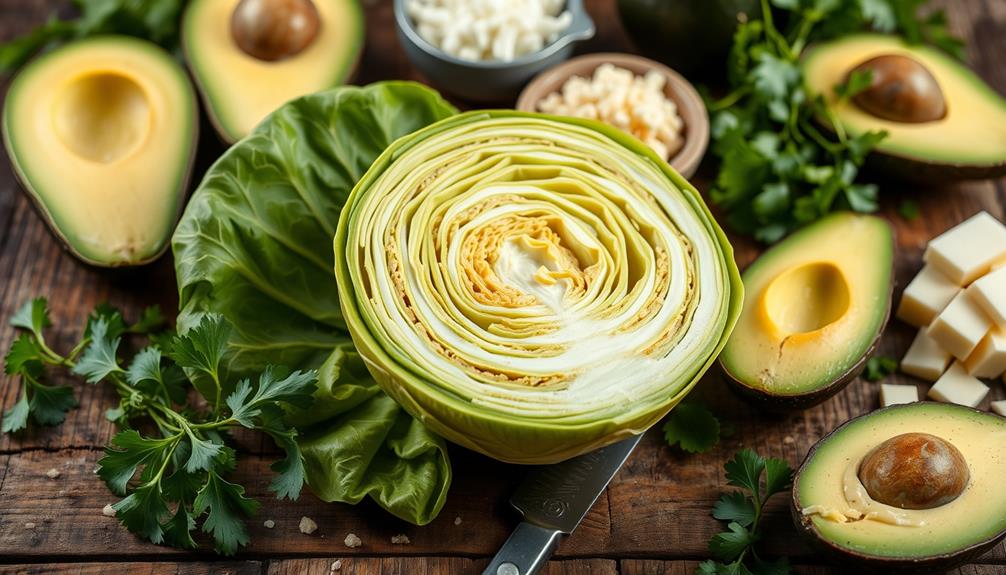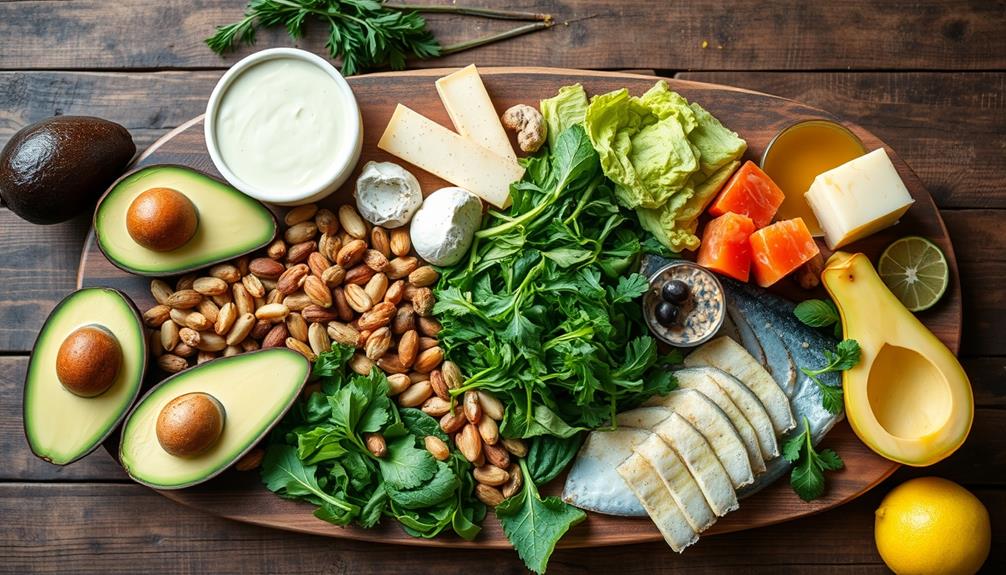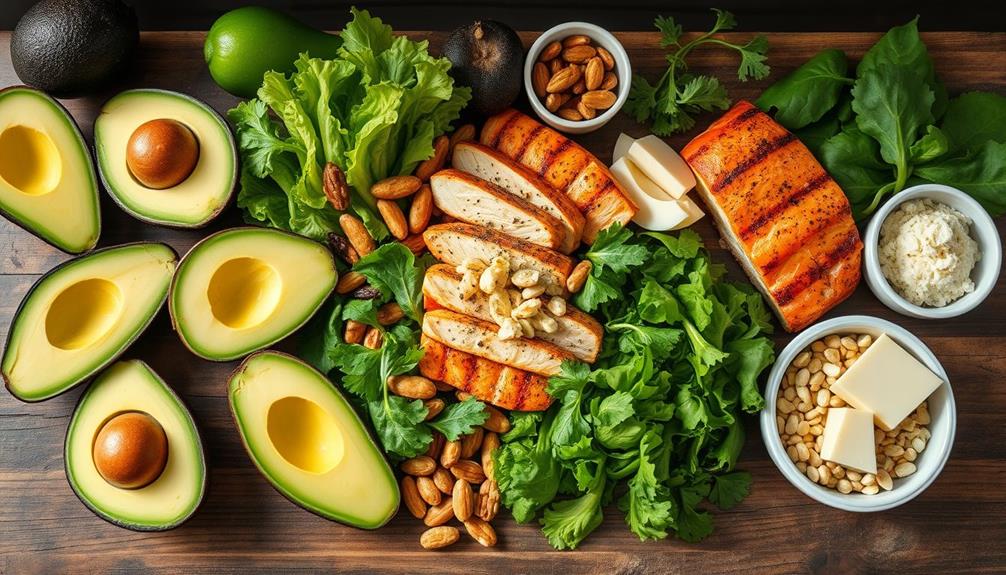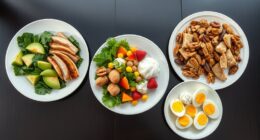The keto diet focuses on high-fat, low-carbohydrate foods that help your body switch from burning glucose to burning fat for energy. You'll want to consume around 75% fat, 20% protein, and only 5% carbohydrates, which means incorporating foods like meats, fatty fish, eggs, full-fat dairy, and low-carb vegetables. Healthy fats from sources like avocados and olive oil are essential. Avoid high-carb foods such as bread, pasta, and sugary snacks to stay in ketosis. If you want to discover even more about how to successfully implement the keto diet, there's plenty more to explore.
Key Takeaways
- The ketogenic diet primarily includes high-fat foods, moderate protein, and very low carbohydrates, typically under 20-50 grams daily.
- Key food categories include animal proteins, low-carb vegetables, healthy fats, full-fat dairy, and low-sugar berries.
- Foods to avoid are high-carbohydrate items like bread, pasta, sugary foods, starchy vegetables, and high-sugar fruits.
- Emphasizing whole foods like meats and non-starchy vegetables enhances nutritional benefits while maintaining ketosis.
- Staying hydrated and planning meals are vital for success on the keto diet and managing potential side effects.
Overview of the Ketogenic Diet
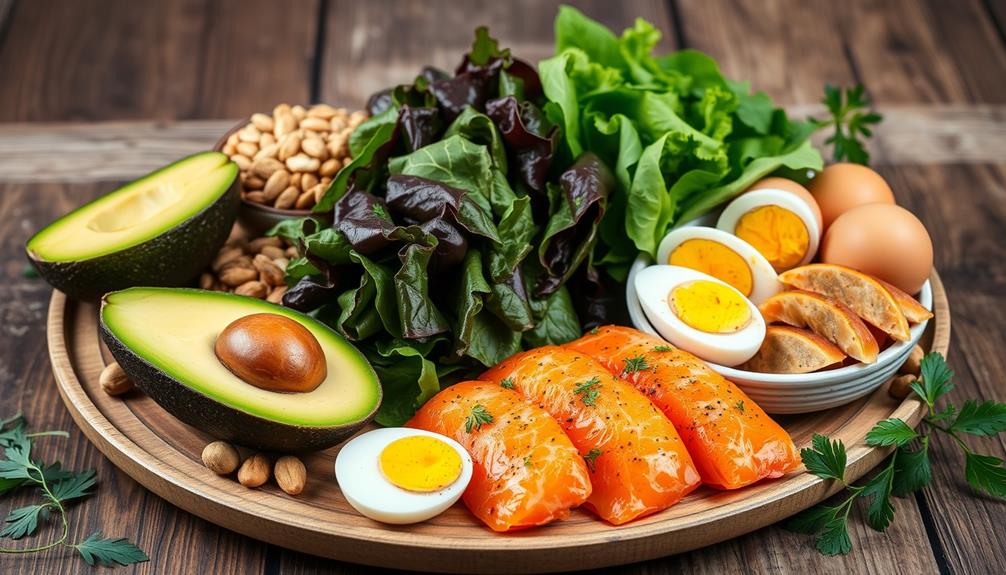
The ketogenic diet's primary goal is to shift your body into a state of ketosis, where it burns fat for fuel instead of carbohydrates. This high-fat, low-carbohydrate approach comprises about 75% fat, 20% protein, and only 5% carbohydrates. By restricting your carb intake to typically below 20-50 grams per day, you stimulate ketone production in your liver, which can help with weight loss and offer various health benefits.
Incorporating regular physical activity is also vital, as it can enhance results and support overall health, particularly cardiovascular health, lifestyle for longevity. The keto diet originated in the 1920s as a treatment for epilepsy, but it has since gained popularity for its potential in promoting fat loss and enhancing overall health. It emphasizes whole foods, focusing on nutrient-dense high-fat options like butter, cheese, eggs, meat, nuts, oils, and fatty fish while limiting fruits, grains, and sweets.
If you're considering this dietary approach, it's important to seek dietary guidance from healthcare professionals. The ketogenic diet may not suit everyone, and some individuals might experience side effects, especially during the initial adaptation phase.
Key Food Categories

When starting on a ketogenic diet, understanding the key food categories is essential for successfully maintaining ketosis and achieving your health goals. First, focus on animal proteins, such as meat, poultry, and seafood. These foods provide high-quality protein with zero carbohydrates, critical for muscle preservation and satiety.
Additionally, it's important to take into account the effects of various foods on your overall health; for example, certain juices may have different implications for your health journey, as noted in juice diets.
Next, incorporate low-carb vegetables into your meals. Non-starchy options like broccoli, spinach, and zucchini are great choices, as they offer fiber and essential nutrients while keeping net carbs low.
You'll also want to prioritize healthy fats. Foods like avocados, olive oil, and nuts are essential for achieving the high-fat content required on a keto diet.
Full-fat dairy products such as cheese, Greek yogurt, and heavy cream should be staples in your kitchen, as they're low in carbohydrates and rich in fat.
Finally, enjoy berries like strawberries and raspberries in moderation. These low-sugar fruits provide antioxidants and fiber while containing markedly fewer carbohydrates compared to other fruits.
Understanding Ketosis

To understand ketosis, you need to recognize how your body shifts its energy source from carbohydrates to fat. By restricting carbs to under 50 grams a day, your liver starts producing ketones, which fuel various tissues, including your brain.
This metabolic change is essential for reaping the full benefits of the keto diet. Additionally, it's important to take into account how your diet can affect other aspects of your health, such as cold medications overview, which may interact with dietary choices.
Ketone Production Process
Achieving ketosis means your body undergoes a remarkable alteration, switching from using carbohydrates to burning fat for fuel. This metabolic state activates ketone production in your liver, where fatty acids break down through lipolysis. Triglycerides convert into free fatty acids and glycerol, which your liver then transforms into ketones—primarily acetoacetate, beta-hydroxybutyrate, and acetone. These ketones serve as a crucial energy source for your body, especially the brain.
To effectively enter ketosis, you typically need to limit your carbohydrate intake to around 20-50 grams daily. This restriction depletes glycogen stores, enhancing fat metabolism and increasing ketone production. Elevated ketone levels signal that you've successfully shifted to burning fat, leading to potential benefits in weight management and blood sugar control.
| Ketone Type | Function |
|---|---|
| Acetoacetate | Primary ketone for energy |
| Beta-Hydroxybutyrate | Major energy source |
| Acetone | Byproduct of ketone metabolism |
| Free Fatty Acids | Converted to ketones |
| Glycerol | Supports energy production |
Understanding this process is essential for making the most of your ketogenic journey.
Importance of Carbohydrate Restriction
Carbohydrate restriction is the cornerstone of the ketogenic diet, crucial for triggering ketosis and enabling your body to shift from burning glucose to burning fat for energy. By limiting your daily carb intake to under 20-50 grams, you can induce a metabolic state where fat oxidation becomes your primary energy source.
When glucose is scarce, your liver converts fatty acids into ketones, which serve as an alternative energy source for both your brain and body. Understanding the importance of common financial terms can also aid in planning for the long-term sustainability of your dietary changes.
Maintaining a high carbohydrate intake can suppress ketone production, making it challenging to sustain ketosis and effectively utilize your fat stores. The ketogenic diet's focus on carbohydrate restriction aims to deplete glycogen stores in your liver and muscles, promoting increased fat oxidation and ultimately leading to weight loss.
Understanding the importance of carbohydrate restriction helps you make informed food choices, ensuring you favor low-carb foods that support your journey into ketosis. By embracing this dietary shift, you not only enhance your energy levels but also tap into a powerful method for achieving your weight loss goals.
Fundamentally, the right balance of carbohydrate restriction is crucial for maximizing the benefits of the ketogenic diet.
Benefits of Keto Foods

Keto foods offer a range of benefits that can alter your health and wellness journey. By focusing on healthy fats and keeping your carbohydrate intake low, you'll encourage your body to enter a state of ketosis. This change promotes fat burning for energy instead of glucose, making it effective for weight loss. You might notice rapid initial weight loss, mainly due to the depletion of glycogen stores and water weight.
Additionally, incorporating certain essential oils, such as eucalyptus oil, can support respiratory health, which may be beneficial during your dietary shift.
Incorporating keto-friendly foods like fatty fish and avocados can greatly enhance your heart health. These foods help improve cholesterol levels by increasing HDL cholesterol while potentially lowering triglycerides. High-fat dairy products, such as cheese and yogurt, provide essential nutrients like calcium and protein, which can enhance feelings of fullness and support muscle preservation.
Don't forget to include non-starchy vegetables in your keto diet. They're packed with vitamins, minerals, and antioxidants while remaining low in carbohydrates, which aids your overall health.
As you embrace keto foods, you'll not only support your weight loss goals but also improve your heart health and overall well-being. The benefits are clear, making this diet a powerful choice for many.
Foods to Include
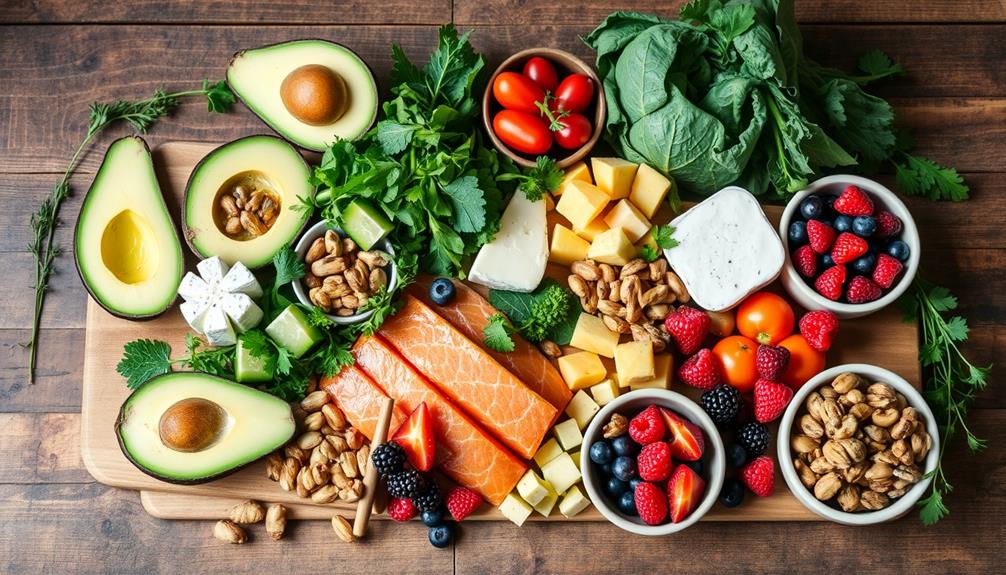
When you're following a keto diet, focusing on nutrient-dense protein sources and healthy fats is key. Incorporating foods like fatty fish, eggs, and avocados not only keeps your meals satisfying but also aligns with your low-carb goals.
Additionally, exploring unique breakfast recipes can provide delicious options that fit within your dietary restrictions.
Let's explore which specific foods can help you thrive on this lifestyle.
Nutrient-Dense Protein Sources
A well-rounded ketogenic diet relies heavily on nutrient-dense protein sources that support muscle preservation and keep you feeling satisfied. Incorporating these protein sources is essential for maintaining your energy levels while staying low in carbs.
Additionally, it's important to be aware of health screenings like mammograms, which can be vital for women, especially as they age, to monitor their health breast cancer symptoms.
Here are four excellent options to include in your keto diet:
- Seafood: Fatty fish like salmon and sardines are nearly carb-free and rich in omega-3 fatty acids. Aim for at least two 3-ounce servings weekly to reap their health benefits.
- Meat and Poultry: Fresh cuts of meat and poultry contain zero carbs and provide high-quality protein. Choosing grass-fed beef can offer additional omega-3s and conjugated linoleic acid (CLA), supporting heart health.
- Eggs: With less than 1 gram of carbs per large egg, they're a nutrient-dense, high-protein option that promotes fullness—perfect for breakfast or snacks.
- Dairy Products: High-fat dairy items like cheese and plain Greek yogurt are low in carbs and rich in protein, contributing essential nutrients and enhancing satiety in your keto diet.
Healthy Fats Essentials
Incorporating healthy fats into your diet is essential for achieving the full benefits of a ketogenic lifestyle. These fats should comprise about 70-80% of your total calorie intake, supporting energy levels and hormone production. Here are some key sources to include:
| Food Item | Benefits |
|---|---|
| Olive Oil | High in oleic acid and antioxidants |
| Coconut Oil | Contains medium-chain triglycerides (MCTs) |
| Avocados | Rich in monounsaturated fats and fiber |
| Fatty Fish | Loaded with omega-3 fatty acids |
Olive oil and coconut oil are great for cooking and dressings, while avocados provide essential nutrients and help maintain healthy cholesterol levels. Nuts and seeds, like almonds and chia seeds, are also excellent choices, offering a healthy dose of fats, fiber, and protein. For instance, a 1-ounce serving of almonds has about 14 grams of fat and only 2.5 grams of net carbs. Fatty fish such as salmon and mackerel are perfect for their omega-3 fatty acids, promoting heart health. Embrace these options to thrive on your keto journey!
Foods to Avoid
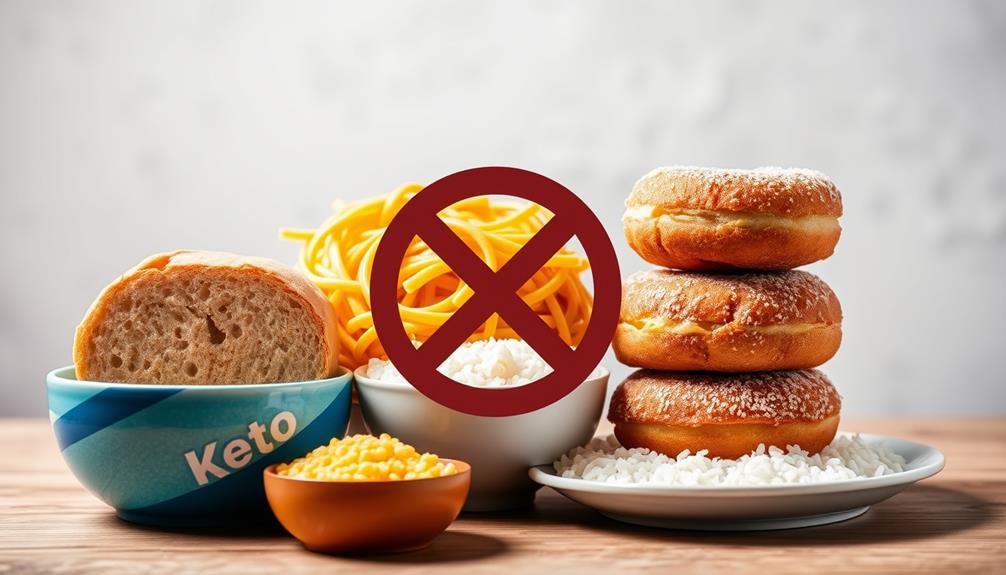
To successfully navigate the keto diet, you'll need to steer clear of certain foods that can derail your progress. Focusing on minimizing your carbohydrate intake is vital for reaching and maintaining ketosis.
Understanding the impact of food choices on your health can greatly enhance your journey; for instance, some people find that unique aroma in homes can motivate them to stick to healthier habits.
Here are some key categories of foods to avoid or limit:
- High-Carbohydrate Foods: Bread, pasta, rice, and grains are significant sources of carbs that can hinder your progress.
- Starchy Vegetables: Potatoes, sweet potatoes, corn, and peas are starchy and should be minimized to keep your carb count low.
- Sugary Foods and Beverages: Candy, desserts, soda, and other sugary items can quickly add up, so eliminate these from your diet.
- High-Sugar Fruits: Fruits like bananas, grapes, and mangoes are high in natural sugars; instead, opt for low-carb options like berries in moderation.
Additionally, be cautious with processed foods such as chips, crackers, and baked goods, as they often contain hidden carbs.
Managing Side Effects

After avoiding high-carb foods, you might start experiencing some side effects as your body adjusts to the keto diet. This phenomenon, commonly referred to as the "keto flu," can manifest as fatigue, headaches, dizziness, and irritability. These symptoms typically last a few days to a week while your body adapts to ketosis.
Staying well-hydrated is essential during this phase; increasing your water and electrolyte intake can alleviate discomfort. Incorporating gentle stretching before bedtime can also help with relaxation and mitigate stress that may arise during this shift sleep better.
To ease your shift, consider gradually reducing your carbohydrate intake instead of making drastic cuts. This approach can help minimize side effects.
Incorporating high-fiber, low-carb vegetables like spinach and broccoli can also mitigate digestive issues, such as constipation, which some people experience on the keto diet.
Additionally, monitor and adjust your fat and protein intake. Excessive protein may hinder ketosis, while adequate fat consumption supports your energy levels during this adjustment period.
Tips for Success
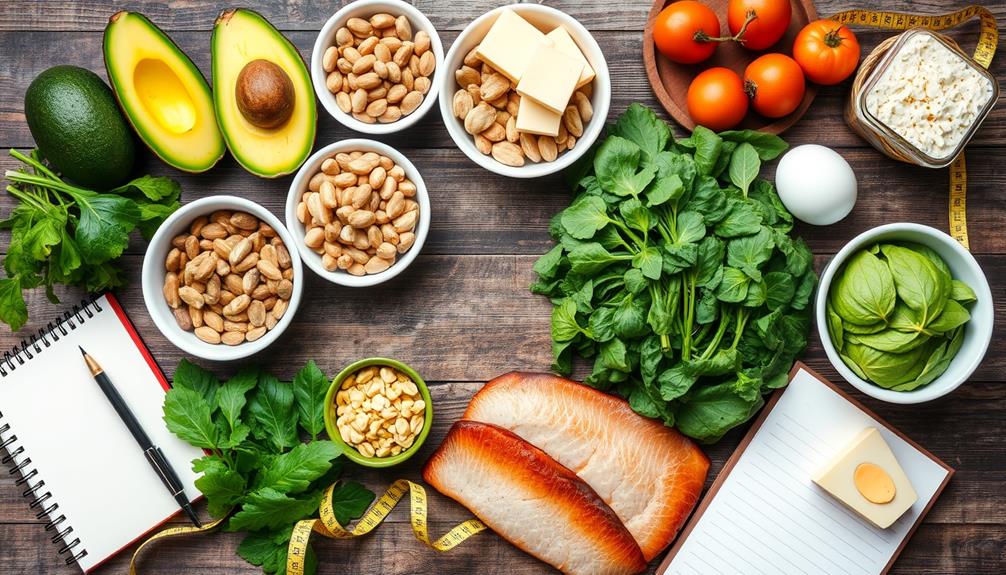
Success on the keto diet hinges on making smart food choices and planning ahead. To thrive on this journey, keep these tips in mind:
1. Focus on Whole Foods: Prioritize unprocessed foods like meats, dairy, and non-starchy vegetables. They're nutrient-dense and help you avoid high-carb temptations.
Additionally, consider the significance of tracking your food intake to maintain your diet effectively, similar to how one should research companies thoroughly before investing.
2. Track Carbohydrate Intake: Aim for under 20-50 grams of carbs daily. Keeping an eye on your intake is vital for maintaining ketosis and maximizing fat burning.
3. Stay Hydrated: Proper hydration is essential. Increase your salt intake during the initial phase to combat "keto flu" symptoms such as fatigue and headaches.
4. Plan Your Meals: Engage in meal planning to incorporate a variety of healthy fats and protein sources. This strategy helps prevent cravings for high-carb options.
Additionally, don't hesitate to consult healthcare professionals or dietitians. They can help you create an individualized approach that meets your nutritional needs while adhering to the keto diet.
Frequently Asked Questions
What Foods Do You Eat on a Keto Diet?
On a keto diet, you'll eat high-fat foods like fatty fish, meats, and eggs. Incorporate non-starchy vegetables, cheese, healthy fats from avocados and nuts, and enjoy berries in moderation to keep your carb intake low. You’ll want to avoid starchy vegetables, sugary fruits, grains, and any processed foods that are high in carbohydrates. When looking for a snack, consider ketofriendly popcorn options made with coconut oil or ghee instead of butter and seasoned with salt or keto-friendly spices. It’s important to read labels and choose snacks that fit within your daily carb limit to maintain ketosis.
What Are the Basic Rules for Keto?
Did you know that nearly 70% of people on keto report weight loss success? To follow keto, you'll consume 70-80% fats, limit carbs to 20-50 grams daily, and prioritize high-fat, low-carb foods.
Are Keto Diets Healthy?
Keto diets can be healthy for some, promoting weight loss and improved blood sugar control. However, they may cause nutrient deficiencies and side effects like fatigue. Always consult a healthcare professional before starting any diet.
What Vegetables Can I Eat on Keto?
Keenly consider colorful, crunchy veggies like cauliflower, kale, and zucchini. You'll enjoy delicious dishes packed with nutrients and minimal carbs. Don't forget about creamy avocados, perfect for satisfying your healthy fat cravings while keeping carbs low!
Conclusion
In the journey of the ketogenic diet, think of your plate as a canvas, where each food choice paints a vibrant picture of health. By embracing high-fat, low-carb foods, you not only ignite the fire of ketosis but also reveal a masterpiece of well-being. Remember, the path may have its bumps, but with careful selections and a dash of creativity, you'll transform your culinary experience into a celebration of energy. Keep painting your path to success!


